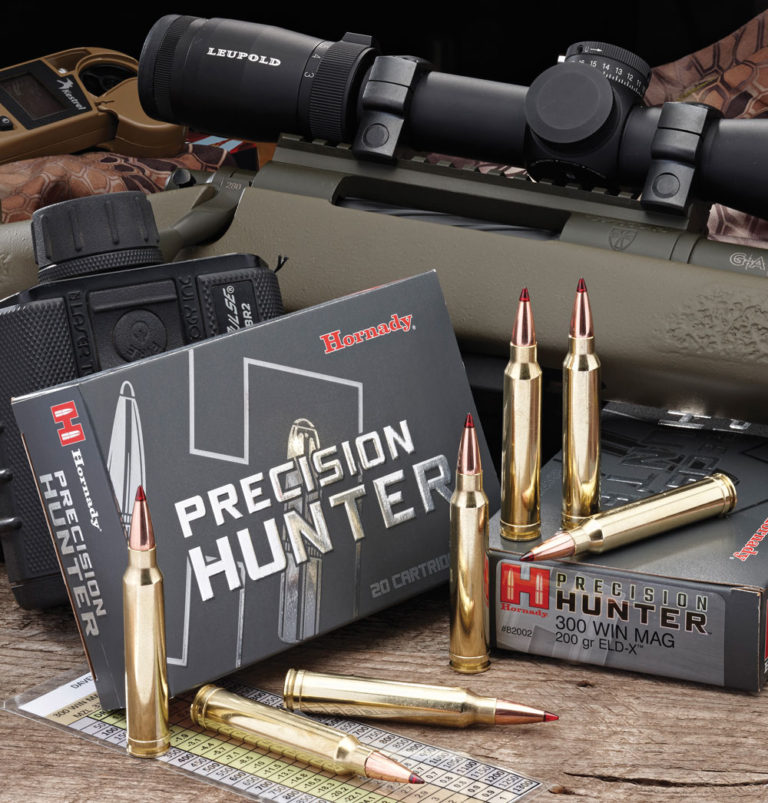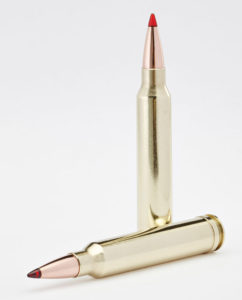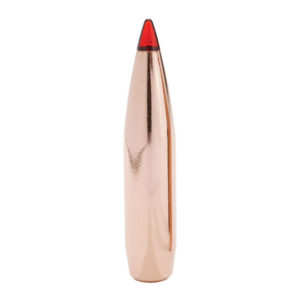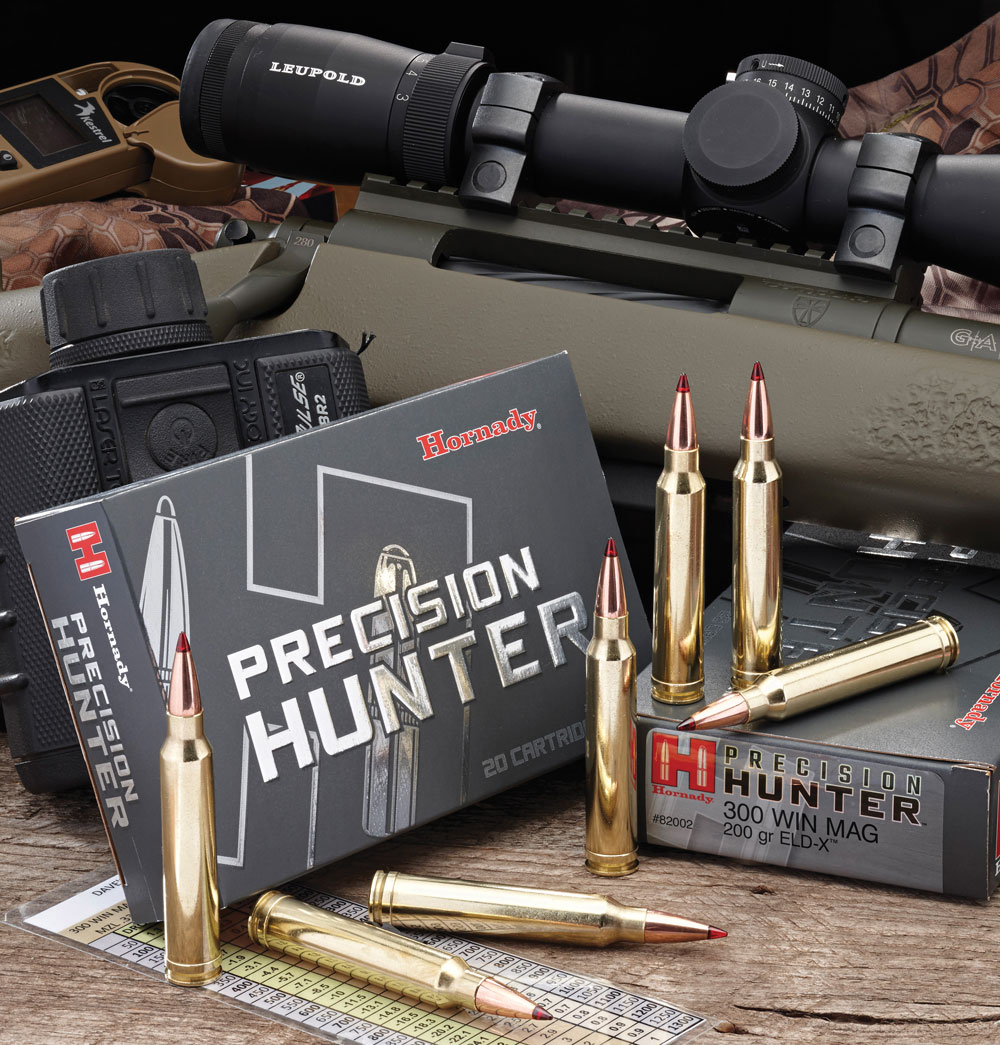
The result of extensive testing with ultra-modern Doppler radar, the new Hornady ELD-X bullet takes long-range shooting to the next level.

It was mid-winter 2014 as I steadied my CZ American custom .300 Win. Mag. across the end gate of the pickup truck while my mind raced for the exact range, level of movement forward and downhill angle required to make a shot on a nice mule deer buck at just over 325 yards. In my rifle was a new cartridge featuring a prototype bullet Hornady Ammunition had been working on for several years.
Hornady had sent out teams of hunters across the country, even as far as Africa, to gain real-time information on just how effective this new 200-grain big-game bullet was downrange, and I was one of these testers. The new bullet had no name at the time save for the term “experimental,” and my job was to shoot a deer with it and to photograph and make notes of what the bullet did at the exact range it met meat and bone.
With a muzzle velocity of 2,800 feet per second (fps) and carrying a ballistic coefficient (BC) of .598, this heavy game cartridge retained plenty of velocity and energy, and as my rifle turned loose that big, heavyweight bullet, the mule deer lurched forward, covered about 5 yards in the knee deep snow, then dropped stone dead.
This had been the beginning of a major sojourn into the world of industry-directed long-range rifle ballistics. I had spent exactly two rounds of the research ammo, with one round put on my 200-yard zero prior to hunting and the second into that mule deer buck.
The following spring, I tested some of the new prototype ammunition on 1,000-yard steel with my Armalite M-30 A-1 and Savage 110 BA rifles. These long-range rifles sported Steiner military MILRAD optics and Weaver’s new military-grade sniper optic system. The ammo performed very well to say the least, and after several weeks of shooting at our club’s 1,000- to 1,500-yard steel plate range, I knew that Hornady was onto something big.
Sometime later, Hornady’s project came together in Grand Island, Nebraska, with a dozen writers and ballistics engineers getting together on a 1,500-yard range near the Hornady ammunition plant. The task was to take part in educational theory regarding Hornady’s newly named ELD-X bullets.
What made these pills so special in relation to previous projectiles, you ask? Well, hang on because the answer to that question gets a bit involved.
The first thing to note regarding these new bullets is that development stops at or about 6.5mm.
That’s because the 6.5 Creedmoor is the development baby of Dave Emery, Hornady’s top ballistics engineer. In effect, the 6.5mm is at about the bottom of lightweights in ELD-X design because the jacket design requires a bullet of enough material substance so as to allow the jacket to be formed and function correctly. This bullet retains a consistent mushrooming system that works at 100 yards but also expands under control at 800 yards.
In the past, we have seen bullets that are great at 200 or 300 yards but fail at 500 yards when designs don’t allow the jacket and core material to flow back and drive killing kinetic energy in mass. In other cases, some bullet designs are great against steel or paper targets, but lack expansion capabilities when warm target tissue is involved at any range.
Doppler Radar

The second element of note came to Hornady engineers largely through the use of Doppler radar. I was introduced to Doppler about nine years ago during the research and development of some new shotshell designs.
At that time we tracked payloads of shot about 200 yards downrange and, in the process, learned a lot about what pellets were doing as shot strings fell apart. Whereas a pattern board and chronograph gave a few measures of performance, the Doppler system fed back hundreds.
Now I was back using Doppler, but this time observing the performance of a rifle bullet over a couple of miles, with thousands of data entries flowing into the system for future bullet design and development review.
What we could see by actual, hands-on, real-time Doppler test firing with a rifle in .300 Win. Mag. and the ELD-X bullets was that well downrange, as the bullet started to run out of velocity, the actual path of the projectile started to wobble and both rise and fall along the Doppler’s projected ballistic curve. In other words, it was becoming less accurate, and some major energy decay became evident.
While this is expected with the radar tracing (painting) the bullet up to 2 miles downrange, what was a real eye-opener for Hornady engineers was that, when standard hollow point, and even V-Max type bullets were fired, some very different prints were coming back to the radar operator.
Now, small jumps and flight changes were common at what is considered working ranges for the .300 Win. Mag. at 300-plus yards and more. However, when searching for the exact causes for this projectile behavior, Hornady assessed that, as the bullet in a V-Max or any brand of plastic tip pill develops a heat range up to 1,000 degrees F for enough time, the plastic tip actually deforms or melts away in part. Solid jacket bullets with even a slight blemish will also display a similar reaction.
Therefore, the bullet tip and overall projectile condition needed to be further considered in the design of a more accurate and energy saving projectile. This doesn’t mean you’re now required to stop using V-Max, A-Max and related cartridges and bullets. The fast, lightweight varmint bullets are not affected to such an extent because they don’t hang in the necessary heat range very long as they dump velocity and energy very quickly.
During hands-on testing of Hornady’s prototype bullet, I had always thought that everything was being directed toward the actual physical bullet body design, I had never figured the plastic or poly tip needed some major attention as well. The new ELD-X carries a very special poly-blended cone tip that will not burn away, become soft and bend, thus, preventing a deviation in bullet trajectory.
Downrange Performance
While I can give you 5,000 words of theory here, the real world comes together when bullets meet steel or paper downrange. When we tested the new ELD-X bullets on the rifle range near Grand Island, there was a damp, heavy fog, and the wind had started generating a 100-percent crossing left to right value. Luckily, the engineers were first up on the firing line.

Two cartridges had been loaded with the new bullets. First was the 7mm Ultra Mag., and second was my go-to cartridge, the .300 Win. Mag. Both were great long-range cartridges and had proven themselves in previous testing with the prototype bullet.
Doppler produces a trace line indicating exactly what the bullet is doing over its total fight time. Shooting V-Max, A-Max and competitive brands downrange, we observed each wobble and variation in the trajectory line to line, with results saved in the mother computer system built into the Doppler unit.
With these 3,000 or so performance points measured over a mile downrange, it was obvious the study of bullet performance has come a long way over the years.
When it was the writers’ time to get on the rifles, I selected a very nicely built Surgeon action .300 Win. Mag. The rifle featured a NightForce optic with MOA settings and a long-range, oversized turret with MOA adjustments to 1,000 without rolling past the first zero.
My spotter was Dave Emery, and with the ranged targets previously doped for the new cartridge/bullet, we dialed for a 500-yard steel plate as Dave called wind corrections. I hit steel plates at 500 and 600 yards a few times to get a feel for the rifle’s trigger before moving on to the 800-yard targets.
At 800 yards, headshots were the norm with the Surgeon rifle and high-grade optics. I was able to hit a large steel gong at 1,000 yards with ease; a cluster of bullets started forming a group of sorts. The accuracy of the new bullet was obvious as I shot 8-inch steel plates at 1,000 yards, and it continued to impress when I pushed the bullet to 1,200 yards against yet another steel target. While I didn’t head-shoot my iron enemy, I did center mass him consistently.
Dave Emery indicated that this ELD-X bullet paired with a quality rifle will group within ¾ MOA at 1,000 all day long. That is elk, deer and coyote accuracy in spades my friends.
Cartridges for the new bullet will be offered in current standard options at first and move into some of the exotics a bit later. Without question the new 6.5 Creedmoor is high on the manufacturing list, as is the .300 Win. Mag. and heavy 7mm cartridges.
There is little doubt that the advanced development design of the ELD-X is going to be a game changer, and this change in the bullet-manufacturing segment is already taking shape.
This article appeared in the January 2016 issue of Gun Digest the Magazine.

Next Step: Get your FREE Printable Target Pack
Enhance your shooting precision with our 62 MOA Targets, perfect for rifles and handguns. Crafted in collaboration with Storm Tactical for accuracy and versatility.
Subscribe to the Gun Digest email newsletter and get your downloadable target pack sent straight to your inbox. Stay updated with the latest firearms info in the industry.


![Best Concealed Carry Guns In 2025 [Field Tested] Wilson Combat EDC X9S 1](https://gundigest.com/wp-content/uploads/Wilson-Combat-EDC-X9S-1-324x160.jpg)


![Best 9mm Carbine: Affordable PCCs [Tested] Ruger Carbine Shooting](https://gundigest.com/wp-content/uploads/Ruger-Carbine-Shooting-100x70.jpg)
![Best AR-15: Top Options Available Today [Field Tested] Harrington and Richardson PSA XM177E2 feature](https://gundigest.com/wp-content/uploads/Harrington-and-Richardson-PSA-XM177E2-feature-100x70.jpg)
